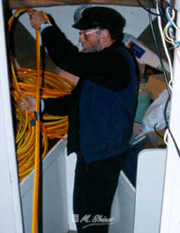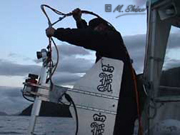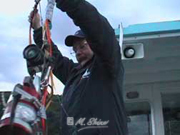Our Search for Crusader
2000 - 2019

| Back to Fieldwork/Groundtruth | |
On September 29 1952 John Cobb, the famous Brooklands
racing hero, holder of many speed records, died after
his boat Crusader disintegrated after hitting a boat-wake
during a world water speed record attempt on Loch Ness.
He became the fastest man on water (206.89mph) though
did not achieve the record since the accident occurred
before he could complete a second run over the measured
mile. In 2002, that enquiry was reconvened by the Loch Ness Project which set out to search for the wreck as a 50th anniversary tribute to Cobb's endevour. Using photography, archive film
and digital image analysis, Adrian Shine began to plot
the probable location of the wreckage of Crusader. Skipper, John Minshull and Adrian spent
many long nights sweeping the plotted line with sonar
and mapping the site. Photographic help and inital calculations from Dick
Raynor. Loch Ness Project and Kongsberg find John Cobb's Crusader wreck with its jet engine 28th April 2019. It was another 19 years before the main wreckage of Crusader was discoverd when Adrian Shine arranged with a film company for Craig Wallace of Kongsberg to bring the Munin AUV for another search. Munin found the remarkably intact aft section of Crusader at the base of the steep north western 'wall' of the loch at a depth of 200m. Craig Wallace arranged to examine the wreck by ROV and on 28th April Deepscan set out. Also on board, were John from Kongsberg, Skipper John Minshull and videographer Maralyn Shine. Alastair Matheson accompanied Gordon Menzies who brought his boat to steady Deepscan over the wreck for the final and successful confirmation of the discovery of Crusader with the jet engine still in place.. More images and the story to follow ...
|
. |



